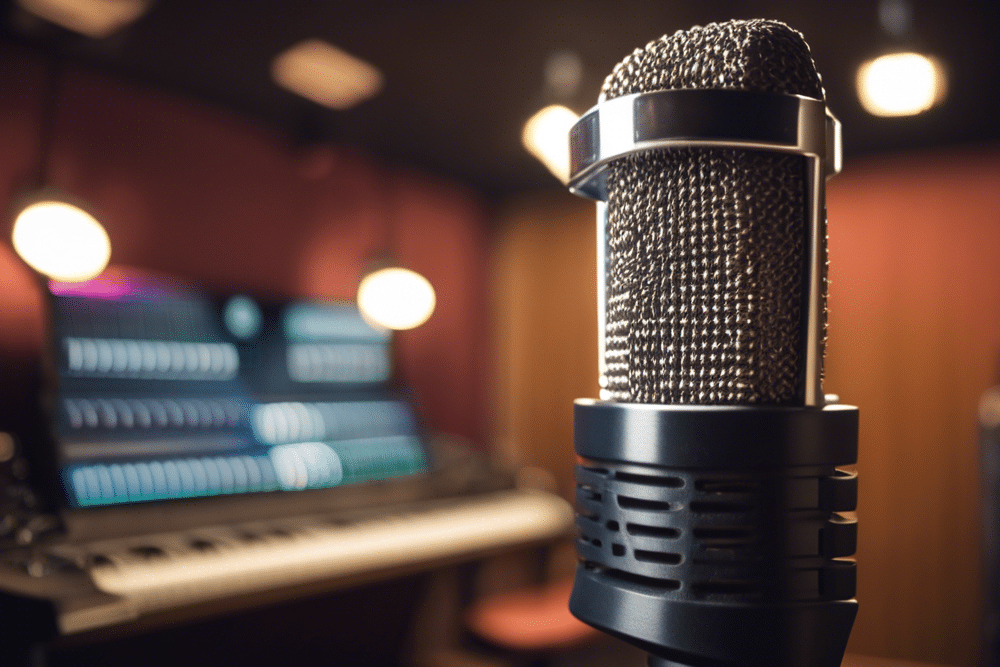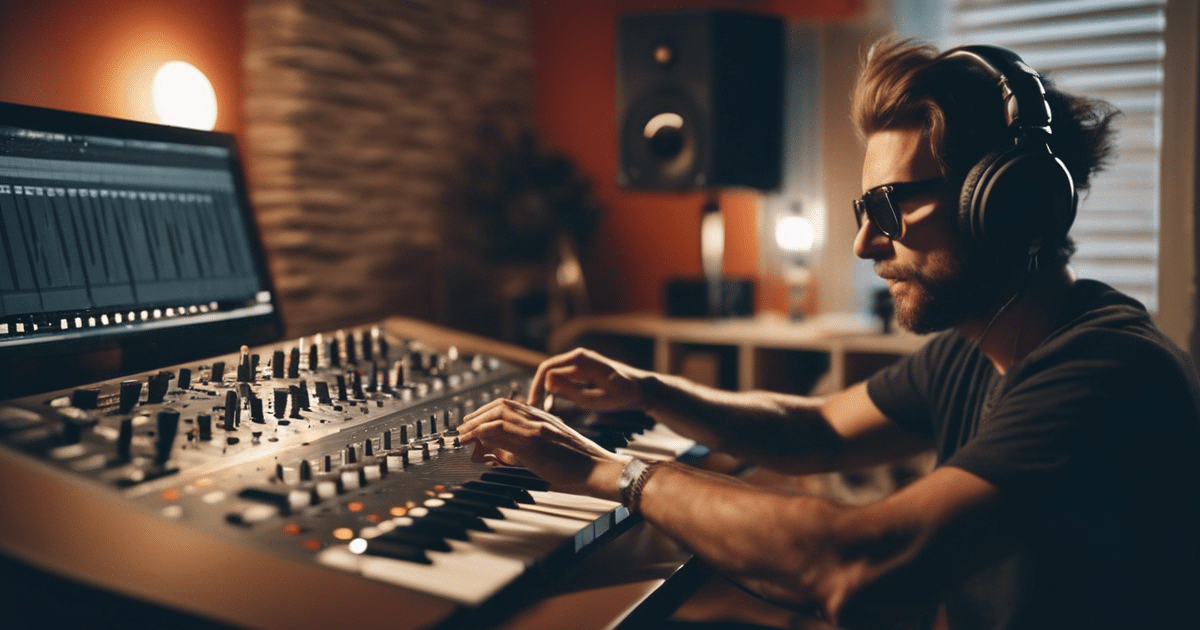Estimated reading time: 9 minutes
Introduction: Embarking on Your Pro Tools Journey
As a music producer, you’re always on the lookout for tools that can elevate your craft. Enter Pro Tools, the industry standard for audio recording and production. Whether you’re a seasoned pro or just starting out, learning how to record on Pro Tools is a game-changer for your music career. In this comprehensive guide, we’ll walk you through the ins and outs of recording with Pro Tools, from setting up your session to capturing that perfect take.
Table of contents
- Introduction: Embarking on Your Pro Tools Journey
- Getting Started: Setting Up Your Pro Tools Session
- Creating Your First Audio Track
- The Recording Process: Capturing Audio in Pro Tools
- Advanced Recording Techniques
- Optimizing Your Recording Setup
- Editing Your Recordings
- Enhancing Your Recordings with Plug-ins
- Troubleshooting Common Recording Issues
- Advanced Pro Tools Features for Recording
- Organizing Your Pro Tools Sessions
- Video: How To Record In Pro Tools For BEGINNERS
- Conclusion: Your Path to Pro Tools Mastery
- FAQs
Getting Started: Setting Up Your Pro Tools Session
Choosing the Right Hardware
Before you dive into recording, it’s crucial to ensure you have the right equipment. At the bare minimum, you’ll need:
- A computer (Mac or PC) that meets Pro Tools’ system requirements
- An audio interface
- Microphones (dynamic or condenser, depending on your needs)
- Headphones or monitor speakers
- Necessary cables (XLR, TRS, etc.)
Your audio interface is the bridge between your microphones and Pro Tools. It converts analog signals to digital data that your computer can process. Make sure your interface is compatible with Pro Tools to avoid any headaches down the line.
Configuring Pro Tools
Once you’ve got your hardware sorted, it’s time to set up Pro Tools:
- Launch Pro Tools and create a new session.
- Set your Sample Rate and Bit Depth. For professional recording, aim for at least 44.1 kHz and 24-bit.
- Configure your Playback Engine to use your audio interface.
- Set up your input and output paths in the I/O Setup window.
Pro Tip: Higher sample rates and bit depths offer better audio quality but also increase file sizes. Balance quality with storage constraints based on your project needs.
Creating Your First Audio Track
Navigating the Pro Tools Interface
The Pro Tools interface might seem daunting at first, but it’s designed for efficiency. Familiarize yourself with these key areas:
- Edit Window: Where you’ll spend most of your time editing audio
- Mix Window: For adjusting levels, panning, and adding effects
- Transport Window: Contains controls for playback, recording, and navigation
Setting Up an Audio Track
To create a new audio track:
- Go to Track > New or use the keyboard shortcut Cmd+Shift+N (Mac) or Ctrl+Shift+N (Windows).
- Choose Mono or Stereo, depending on your recording needs.
- Select the appropriate input for your audio interface in the track’s Input selector.
- Arm the track for recording by clicking the Record Enable button.
The Recording Process: Capturing Audio in Pro Tools
Setting Levels and Avoiding Clipping
Before you hit that record button, it’s crucial to set your input levels correctly:
- Enable Input Monitoring on your track to hear the incoming signal.
- Adjust the input gain on your audio interface while watching the track’s meter in Pro Tools.
- Aim for peaks around -12 dB to -6 dB to leave headroom and avoid clipping.
Remember: It’s always better to record at a lower level than to risk distortion from clipping. You can always boost the signal later, but you can’t fix a clipped recording.
Recording Your First Take
Now that everything’s set up, it’s time to record:
- Position your microphone appropriately for your source (voice, instrument, etc.).
- Click the Record Enable button on your track if you haven’t already.
- Set your recording start point using the playhead or by entering a specific timecode.
- Click the Record button in the Transport window or press 3 on your numeric keypad.
- Begin your performance.
- When you’re done, click Stop or press the spacebar.
Congratulations! You’ve just recorded your first take in Pro Tools.
Advanced Recording Techniques
Using Pre-Roll and Post-Roll
Pre-roll and post-roll are features that allow you to hear a section of audio before and after your recording point. This can help you get into the groove before recording starts and ensure a smooth transition at the end.
To use pre-roll and post-roll:
- In the Transport window, click the Pre-Roll and/or Post-Roll button.
- Set the desired pre-roll and post-roll times in the pop-up window.
- Enable the feature by clicking the button again.
Recording Multiple Takes with Playlists
Playlists in Pro Tools allow you to record multiple takes of the same part without creating new tracks. Here’s how:
- Record your first take as normal.
- In the track’s playlist selector, choose “New” to create a new playlist.
- Record your next take. It will be on a separate playlist within the same track.
- Repeat as needed for additional takes.
This technique is great for vocal recordings or guitar solos where you want to try different approaches.
Optimizing Your Recording Setup
Choosing the Right Microphone
Your choice of microphone can significantly impact your recording quality. Here are some general guidelines:
- Dynamic microphones: Great for loud sources like drums or guitar amps
- Large-diaphragm condenser microphones: Ideal for vocals and acoustic instruments
- Small-diaphragm condenser microphones: Excellent for capturing detailed high frequencies
Experiment with different microphones to find what works best for your sound sources and recording space.

Managing Latency
Latency is the delay between input and output in digital audio systems. To minimize latency:
- Lower your buffer size in the Playback Engine settings.
- Use the Low Latency Monitoring option if available.
- Consider using direct monitoring through your audio interface for zero-latency monitoring.
Remember, lower buffer sizes increase the strain on your computer’s CPU, so find a balance that works for your system.
Editing Your Recordings
Basic Editing Tools
Pro Tools offers a range of editing tools to refine your recordings:
- Trimmer Tool: Adjust the start and end points of audio clips
- Selector Tool: Select portions of audio for editing or processing
- Grabber Tool: Move audio clips around the timeline
- Scrubber Tool: Audition audio by clicking and dragging
Familiarize yourself with these tools to speed up your editing workflow.
Using Elastic Audio
Elastic Audio is a powerful feature in Pro Tools that allows you to manipulate the timing of audio without changing its pitch. To use Elastic Audio:
- Right-click on an audio clip and choose “Elastic Properties.”
- Select the appropriate Elastic Audio algorithm for your material.
- Use the Warp markers to adjust the timing of specific points in the audio.
This tool is invaluable for tightening up performances or creating rhythmic effects.
Enhancing Your Recordings with Plug-ins
Essential Plug-ins for Recording
Pro Tools comes with a suite of built-in plug-ins that can enhance your recordings:
- EQ III: Shape the frequency balance of your tracks
- Compressor/Limiter Dynamics III: Control dynamic range
- D-Verb: Add space and depth with reverb
Experiment with these plug-ins during recording to shape your sound, but be cautious about committing effects to your raw recordings.
Using Inserts vs. Sends
When applying effects, you have two main options:
- Inserts: Apply the effect directly to the track
- Sends: Route a portion of the signal to an auxiliary track with effects
Inserts are great for essential processing like EQ and compression, while sends are ideal for shared effects like reverb or delay.

Troubleshooting Common Recording Issues
Dealing with Unwanted Noise
Unwanted noise can ruin an otherwise perfect take. Here are some tips to minimize noise:
- Use a pop filter for vocal recordings to reduce plosives
- Apply a high-pass filter to remove low-frequency rumble
- Use noise gates to cut out background noise between phrases
- Consider acoustic treatment for your recording space
Addressing Clipping and Distortion
If you’re experiencing clipping or distortion:
- Check your input levels and reduce gain if necessary
- Use a pad on your microphone or audio interface if available
- Move the microphone further from loud sources
- Consider using a dynamic microphone for very loud sources
Advanced Pro Tools Features for Recording
Quick Punch Recording
Quick Punch allows you to seamlessly drop in and out of recording to fix mistakes:
- Set your punch-in and punch-out points on the timeline
- Enable Quick Punch in the Transport window
- Begin playback before your punch-in point
- Pro Tools will automatically start and stop recording at your specified points
Loop Recording
Loop recording is great for capturing multiple takes of a section:
- Set your loop boundaries using the Loop Playback button
- Enable Loop Record in the Transport window
- Start recording, and Pro Tools will create a new playlist for each pass through the loop
Organizing Your Pro Tools Sessions
Naming Conventions and Track Colors
Establish a consistent naming convention for your tracks and use track colors to visually organize your session. For example:
- Lead Vocals: Red
- Backing Vocals: Pink
- Guitars: Green
- Drums: Blue
Using Groups and VCA Masters
Grouping related tracks and using VCA masters can streamline your mixing process:
- Select the tracks you want to group
- Right-click and choose “Group”
- Create a VCA master to control the entire group with a single fader
Video: How To Record In Pro Tools For BEGINNERS
Conclusion: Your Path to Pro Tools Mastery
Learning how to record on Pro Tools is just the beginning of your journey. As you continue to explore its features and refine your techniques, you’ll discover new ways to bring your musical vision to life. Remember, great recordings start with great performances, so focus on capturing the best possible source material.
Keep experimenting, stay curious, and don’t be afraid to push the boundaries of what’s possible in Pro Tools. With practice and persistence, you’ll be creating professional-quality recordings in no time.
Final Tip: Always back up your Pro Tools sessions regularly. Nothing is more heartbreaking than losing hours of work due to a technical glitch or hardware failure.
Happy recording, and may your Pro Tools sessions be filled with musical magic! In addition to Pro Tools, there are many other DAWs that are worth a look. Take a look here if you’re looking for a Pro Tools alternative.
Related Posts
FAQs
To begin recording with Pro Tools, you’ll need a computer that meets its system requirements, an audio interface, microphones, headphones or monitor speakers, and necessary cables like XLR or TRS. Ensure your audio interface is compatible with Pro Tools for smooth recording.
Launch Pro Tools, create a new session, and set your sample rate and bit depth (at least 44.1 kHz and 24-bit for professional quality). Configure your Playback Engine to use your audio interface and set up input and output paths in the I/O Setup window.
To prevent clipping, set input levels correctly. Enable Input Monitoring, adjust the input gain on your audio interface, and aim for peaks between -12 dB and -6 dB. This leaves headroom for later adjustments and avoids distortion from high levels.
Playlists let you record multiple takes on the same track without creating new tracks. Record your first take, then create a new playlist from the track’s playlist selector. Record the next take, and it will be stored separately, allowing you to review and select the best version later.
Lower your buffer size in the Playback Engine settings and use Low Latency Monitoring if available. For zero-latency monitoring, use direct monitoring through your audio interface. Be mindful that reducing buffer size increases CPU load, so find a balance that suits your system.
